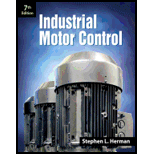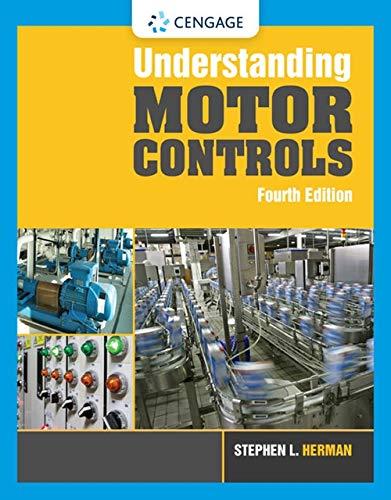
Industrial Motor Control
7th Edition
ISBN: 9781133691808
Author: Stephen Herman
Publisher: Cengage Learning
expand_more
expand_more
format_list_bulleted
Question
Chapter 61, Problem 1RQ
To determine
The words for which UJT stand for.
Expert Solution & Answer
Explanation of Solution
The UJT stands for unijunction transistor, it is the three terminal device that has only one junction and works as an electrically controlled switch.
The two terminals of the UJT act as the base of the device and one of the terminal as the emitter. As the unijunction transistor has two states that are on and off it is a digital device.
Thus, the letters UJT stands for unijunction transistor
Want to see more full solutions like this?
Subscribe now to access step-by-step solutions to millions of textbook problems written by subject matter experts!
Students have asked these similar questions
Just do Questions 7, 9, 11. Here are notes attached for reference. I prefer handwritten solutions. ONLY UPLOAD A SOLUTION IF YOU ARE SURE ABOUT THE ANSWER PLEASE. (If you have once answered this question don't answer it again I am looking for a difference solution)
This is a tilt and rotation question. Here are notes attached for reference. I prefer handwritten solutions. ONLY UPLOAD A SOLUTION IF YOU ARE SURE ABOUT THE ANSWER PLEASE. I prefer handwritten solutions.
Homework#7
Knowledge Booster
Learn more about
Need a deep-dive on the concept behind this application? Look no further. Learn more about this topic, mechanical-engineering and related others by exploring similar questions and additional content below.Similar questions
- Homework#7arrow_forwardQ3. Consider an inlet flow for an engine with a supersonic inlet Mach number as shown in Figure. below, calculate the total pressure loss between point 1 and 3 if the flow passes first an oblique shock wave and then a reflected shock wave. (30 pts) Моо M∞ = 2.0 && = 30°arrow_forwardJust do Questions 7, 9, 11. Here are notes attached for reference. I prefer handwritten solutions. ONLY UPLOAD A SOLUTION IF YOU ARE SURE ABOUT THE ANSWER PLEASE. (If you have once answered this question don't answer it again)arrow_forwardThis is a tilt and rotation question. Here are notes attached for reference. I prefer handwritten solutions. ONLY UPLOAD A SOLUTION IF YOU ARE SURE ABOUT THE ANSWER PLEASE. I prefer handwritten solutions.arrow_forwardPlease explain each steparrow_forwardJust do Questions 7, 9, 11. Here are notes attached for reference. I prefer handwritten solutions. ONLY UPLOAD A SOLUTION IF YOU ARE SURE ABOUT THE ANSWER PLEASE.arrow_forwardExample Consider the simplified model of an automobile shown in Figure, let the parameter have the values m = 1500 kg, Ic = 2000 kg m2, k₁ = 36000 kg/m, k₁ = 40000 kg/m, a = 1.3 m and b = 1.7 m, calculate the natural modes of the system and write the expression for the response. ט 0 Solution T Equilibrium position 6(1)arrow_forward6.3 Contamination of vegetable oil Vegetable oil is used in a food processing factory to prepare instant breadcrumbs. A stirred tank is used to hold the oil. During operation of the breadcrumb process, oil is pumped from the tank at a rate of 4.8 1 h-¹. At 8 PM during the night shift, the tank is mistakenly connected to a drum of cod liver oil, which is then pumped into the tank. The volume of vegetable oil in the tank at 8 PM is 60 1. (a) If the flow rate of cod liver oil into the tank is 7.5 1h-1 and the tank has a maximum capacity of 100 1, will the tank overflow before the factory manager arrives at 9 AM? Assume that the density of both oils is the same. (b) If cod liver oil is pumped into the tank at a rate of 4.8 1 h 1 instead of 7.5 1 h−1, what is the composition of oil in the tank at midnight?arrow_forward6.1 Dilution of sewage In a sewage treatment plant, a large concrete tank initially contains 440,000 litres of liquid and 10,000 kg of fine suspended solids. To flush this material out of the tank, water is pumped into the vessel at a rate of 40,000 1 h −1. Liquid containing solids leaves at the same rate. Estimate the concentration of suspended solids in the tank at the end of 5 h. State your assumptions.arrow_forward6.13 Heating glycerol solution An adiabatic stirred tank is used to heat 100 kg of a 45% glycerol solution in water. An electrical coil delivers 2.5 kW of power to the tank; 88% of the energy delivered by the coil goes into heating the vessel contents. The glycerol solution is initially at 15°C. (a) Write a differential equation for the energy balance. (b) Integrate the equation to obtain an expression for temperature as a function of time. (c) Assuming glycerol and water form an ideal solution, how long will the solution take to reach 90°C?arrow_forwardI don't see any other way to try to solve this problem can you please help me out with this?arrow_forwardHomework#7arrow_forwardarrow_back_iosSEE MORE QUESTIONSarrow_forward_ios
Recommended textbooks for you
 Understanding Motor ControlsMechanical EngineeringISBN:9781337798686Author:Stephen L. HermanPublisher:Delmar Cengage Learning
Understanding Motor ControlsMechanical EngineeringISBN:9781337798686Author:Stephen L. HermanPublisher:Delmar Cengage Learning Refrigeration and Air Conditioning Technology (Mi...Mechanical EngineeringISBN:9781305578296Author:John Tomczyk, Eugene Silberstein, Bill Whitman, Bill JohnsonPublisher:Cengage Learning
Refrigeration and Air Conditioning Technology (Mi...Mechanical EngineeringISBN:9781305578296Author:John Tomczyk, Eugene Silberstein, Bill Whitman, Bill JohnsonPublisher:Cengage Learning Welding: Principles and Applications (MindTap Cou...Mechanical EngineeringISBN:9781305494695Author:Larry JeffusPublisher:Cengage Learning
Welding: Principles and Applications (MindTap Cou...Mechanical EngineeringISBN:9781305494695Author:Larry JeffusPublisher:Cengage Learning Precision Machining Technology (MindTap Course Li...Mechanical EngineeringISBN:9781285444543Author:Peter J. Hoffman, Eric S. Hopewell, Brian JanesPublisher:Cengage Learning
Precision Machining Technology (MindTap Course Li...Mechanical EngineeringISBN:9781285444543Author:Peter J. Hoffman, Eric S. Hopewell, Brian JanesPublisher:Cengage Learning

Understanding Motor Controls
Mechanical Engineering
ISBN:9781337798686
Author:Stephen L. Herman
Publisher:Delmar Cengage Learning

Refrigeration and Air Conditioning Technology (Mi...
Mechanical Engineering
ISBN:9781305578296
Author:John Tomczyk, Eugene Silberstein, Bill Whitman, Bill Johnson
Publisher:Cengage Learning

Welding: Principles and Applications (MindTap Cou...
Mechanical Engineering
ISBN:9781305494695
Author:Larry Jeffus
Publisher:Cengage Learning

Precision Machining Technology (MindTap Course Li...
Mechanical Engineering
ISBN:9781285444543
Author:Peter J. Hoffman, Eric S. Hopewell, Brian Janes
Publisher:Cengage Learning
Lec21, Part 5, Strain transformation; Author: Mechanics of Materials (Libre);https://www.youtube.com/watch?v=sgJvz5j_ubM;License: Standard Youtube License